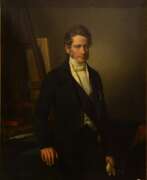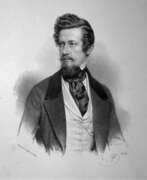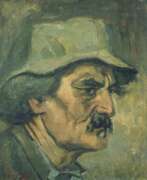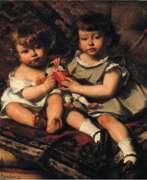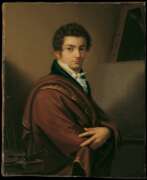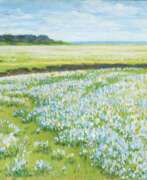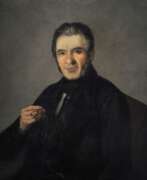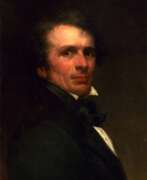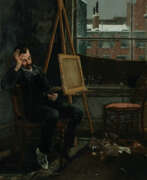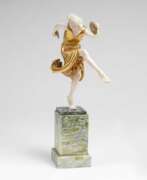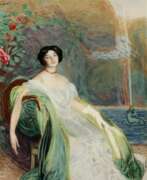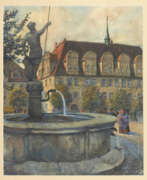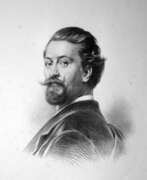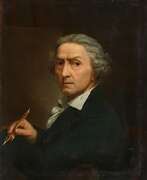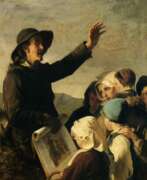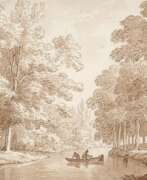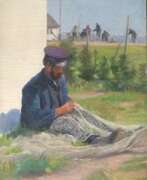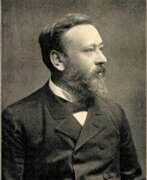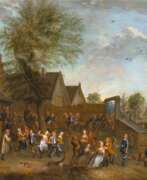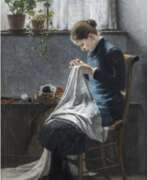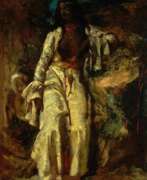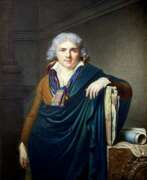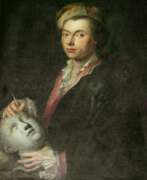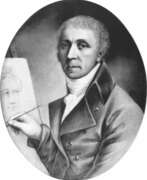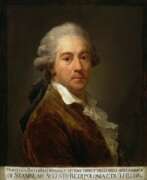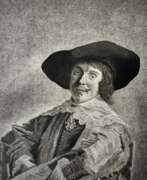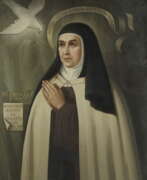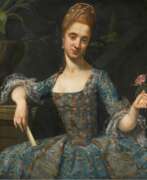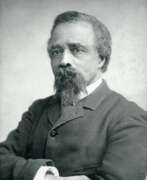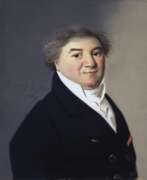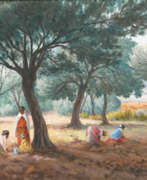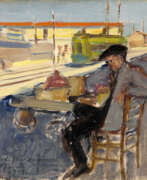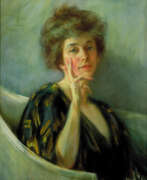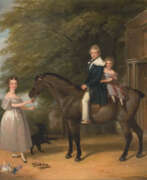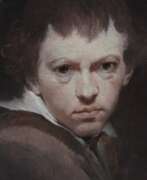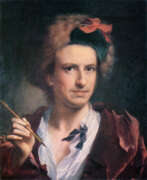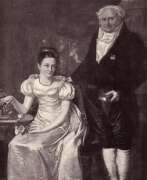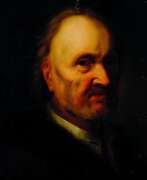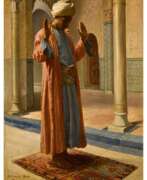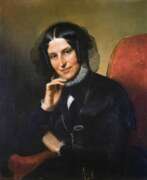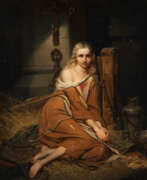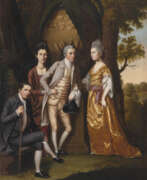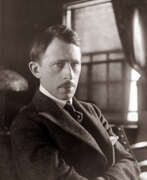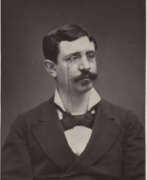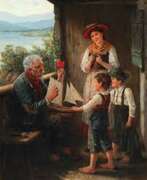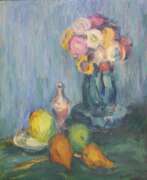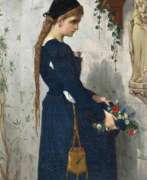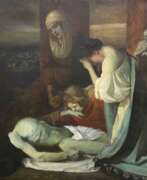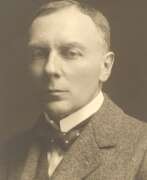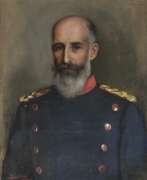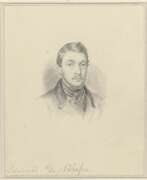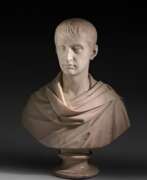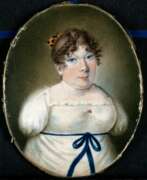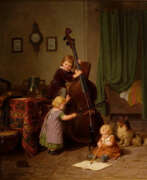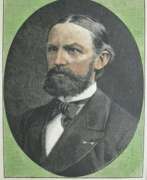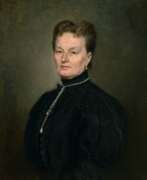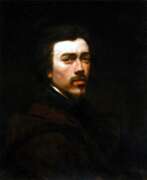Portraitist 19th century
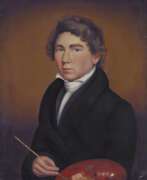

William Matthew Prior was an American folk artist known for his portraits, particularly of families and children.
About 1,500 portraits are attributed to Prior. His works are in many museums and institutions around the United States including the Harvard Art Museums, Museum of Fine Arts, Boston, and the National Gallery of Art.
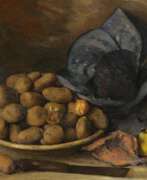

Wilhelm Schmurr was a German painter and co-founder of the Sonderbund in Düsseldorf. His style, characterized by clear expression, was influenced by the Pre-Raphaelites, Symbolists, and Realists. He received several awards and medals for his work and was a member of various art associations. Schmurr taught at the Kunstakademie Düsseldorf and inspired by the farmers after the war, he created scenes of simple life and still lifes. He was awarded the Karl-Ernst-Osthaus-Preis and the Bundesverdienstkreuz erster Klasse and became an honorary member of various artist associations.
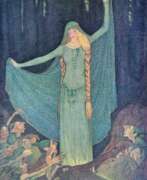

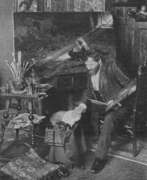

Julius Anton Adam was a German genre painter and animalist who specialised in the depiction of cats and was a member of an influential family of Munich painters.
Julius Anton Adam was a pupil of Professor Michael Echter and later Wilhelm von Dietz at the Munich Academy of Art. He later became a professor himself.
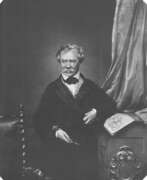

Albrecht Adam was a Bavarian painter of the first half of the 19th century. He is best known for the fact that as a member of Napoleon's Grand Army he took part in the campaign against Russia in 1812 as the official artist of the headquarters of the IV (Italian) Corps. Throughout the campaign, the artist made sketches and drawings, capturing many of the important events of the campaign. Later, many of these sketches became the basis for full-fledged paintings, and to subjects from the Napoleonic wars, which he witnessed, Adam addressed until the end of his very long life.
Albrecht Adam was also the author of memoirs, in which he described in detail the Battle of Borodino and a number of other key events of the War of 1812.
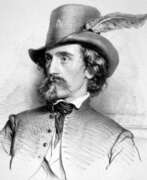

Joseph Matthäus Aigner was an Austrian portrait painter, who studied under Friedrich von Amerling and Carl Rahl. He painted portraits of Franz Joseph I of Austria and his wife Elizabeth, Franz Grillparzer, Friedrich Halm, Nikolaus Lenau, and Maximilian I of Mexico.
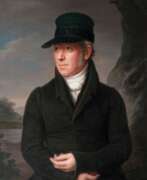

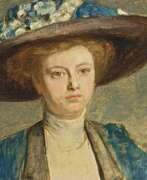

August Allebé was an artist and teacher from the Northern Netherlands. His early paintings were in a romantic style, but in his later work he was an exponent of realism and impressionism. He was a major initiator and promoter of Amsterdam Impressionism, the artist's association St. Lucas, and the movement of the Amsterdamse Joffers. Amsterdam Impressionism – sometimes referred to by art historians as the School of Allebé – was the counterflow to the very strong Hague School in the movement of Dutch Impressionism. As a professor at the Royal Academy of Amsterdam (Rijksakademie van beeldende kunsten) he fostered a cosmopolitan attitude toward art and the promotion and motivation of his students, and provided a significant stimulus to developments in modern art.
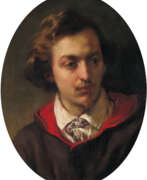

Wilhelm Amberg was a German genre painter. He was educated by the painters Carl Joseph Begas in Berlin and Léon Cogniet in Paris (1845). After this he spent a couple of years in Rome. His paintings are characterized by humour and a poetic atmosphere.
Wilhelm Amberg has won many awards and from 1886 was a Member of the Senate of the Prussian Academy of Arts, Berlin.
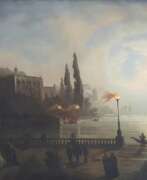

Gustav Adolf Amberger was a German painter and graphic artist. He lived in Rome for two years and learned the painting trade from Peter von Cornelius. One of his first works was the painting The Oceanides. Amberger worked as a designer in the ribbon factory founded by Philipp Trüdinger. Around 1870 he was the court painter to the Landgrave of Hesse. In Antwerp he was a pupil of Joseph van Lerius and made numerous copies, of which Les deux voies is the best known.
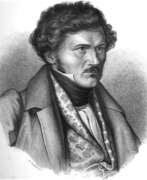

Samuel Amsler is a Swiss engraver. He studied his art under Johan Heinrich Lips and Karl Ernst Hess, at Munich, and from 1816 pursued it in Italy, and chiefly at Rome, till in 1829 he succeeded his former master Hess as professor of engraving in the Munich academy. The works he designed and engraved are remarkable for the grace of the figures, and for the wonderful skill with which he retains and expresses the characteristics of the original paintings and statues. He was a passionate admirer of Raphael, and had great success in reproducing his works.
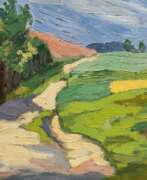

Louise Elisabeth Andrae was a German Post-Impressionist landscape painter and watercolorist. She studied with two landscape painters; Gustav Adolf Thamm in Dresden and Hans von Volkmann in Karlsruhe. She settled in Dresden, but spent long periods on the island of Hiddensee. There, she helped organize a group known as the Hiddensoer Künstlerinnenbund, an association of women artists that included Clara Arnheim, Elisabeth Büchsel, Käthe Loewenthal and Katharina Bamberg. They were regular exhibitors at an art venue known as the Blaue Scheune (Blue Barn), established in 1920 by Henni Lehmann. She also exhibited frequently with a group known as the Kunstkaten in Ahrenshoop.Wikipedia
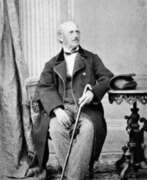

Hermann Anschütz was a German painter of the 19th century. He is known as a painter and teacher who belonged to the Düsseldorf School of painting. He was a professor at the Munich Academy of Fine Arts.
Anschütz painted mythological and historical subjects, as well as landscapes and portraits. A number of his canvases were devoted to oriental themes. In 1860 he was one of the founders of the Munich Christian Art Association.
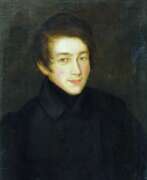

Nikolai Ivanovich Argunov (Russian: Николай Иванович Аргунов) was a Russian painter of the late 18th - the first third of the 19th centuries. He is known as a painter, graphic artist, miniaturist, representative of Russian classicism.
Nikolai Argunov is considered one of the greatest portrait painters of his time. His works are notable for their diversity, psychologism, objective approach to nature, devoid of classicist idealization and romantic heroization of the models.
The artist was a serf, was granted his freedom after the death of his master and became an academician of the Imperial Academy of Arts in St. Petersburg. He was a member of a dynasty of artists, the beginning of which began with his father Ivan Argunov.
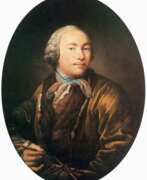

Ivan Petrovich Argunov (Russian: Иван Петрович Аргунов) was a distinguished Russian painter of the 18th century, celebrated for his significant contribution to portrait art. As a serf born into the Argunov family, who were established artists themselves, Ivan's talent was nurtured and supported by his patrons, leading to a unique position within the cultural and artistic hierarchies of his time. His specialization in portraiture allowed him to capture the essence of Russia's social elites, including members of the imperial family, as well as ordinary Russians, thereby providing a wide-ranging visual documentation of the era's societal strata.
Argunov's art is noted for its meticulous attention to detail, vibrant realism, and the emotional depth he brought to his subjects. His portraits are more than mere representations; they are intimate glimpses into the lives and characters of his sitters. Among his most famous works is the portrait of Princess Natalia Petrovna Golitsyna, showcased in the Tretyakov Gallery in Moscow. This particular piece stands out for its intricate portrayal of fabric textures and the detailed rendering of facial expressions, which have been lauded for their lifelike quality and depth.
Argunov's legacy extends beyond his artistic achievements; he played a pivotal role in shaping the course of Russian portraiture. His works are preserved in major museums and galleries across Russia, serving as a testament to his skill and the cultural richness of his time. For collectors and experts in art and antiques, Argunov's paintings are not just historical artifacts but are cherished for their aesthetic value and the insight they offer into 18th-century Russian culture.
We invite enthusiasts and collectors to stay connected with us for updates on new product sales and auction events related to Ivan Petrovich Argunov. By signing up, you will gain exclusive access to the finest pieces of Russian art and antiques, ensuring you never miss an opportunity to enrich your collection with works by one of Russia's most esteemed artists.
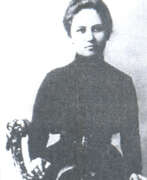

Lydia Ivanovna Arionescu-Baillayre (Russian: Лидия Ивановна Арионеско-Балльер) was an early twentieth-century Russian artist of Moldovan origin. She is known as a painter, a representative of Post-Impressionism and Neo-Impressionism.
Lydia Arionescu-Baillayre created still lifes and portraits. She was a member of the first St. Petersburg society of experimental and innovative artists "Union of Youth".
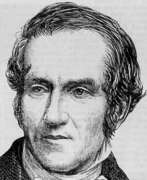

Hezekiah Augur was an American sculptor and inventor. He was self-taught and, unlike many other American sculptors of the 19th century, spent his entire career in New Haven.
Hezekiah Augur was the son of a carpenter and learned the woodcarving trade early on. He later invented a lace loom and a machine for carving piano legs. He then switched to marble.
Hezekiah Augur was a member of the Connecticut Academy of Arts and Sciences.
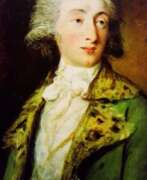

Carl Daniel David Friedrich Bach was a German artist of the late eighteenth and early nineteenth centuries, the Baroque period. He is known as a painter, graphic artist and printmaker.
Bach worked in the historical genre, was a portraitist, animalist, created canvases on allegorical subjects in the spirit of his era. In his works he combined elements of baroque and classicism. The artist often worked in the etching needle technique.
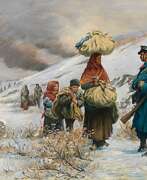

Rodolphe Auguste Bachelin was a Swiss landscape, history and portrait painter as well as a writer, historian and art critic.
He was interested in the Lombardy War of 1859 and in particular in the Franco-Prussian War of 1870 to 1871, which provided him with several subjects with its troop surge at Les Verrières. The Neuchâtel painter was greatly influenced by the writings of Rodolphe Töpffer and aspired to become a Swiss national painter.
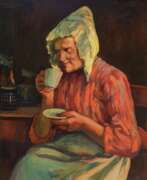

Gottfried Albert Maria Bachem was a German painter and illustrator of the Düsseldorf School. Bachem, who belonged to the Malkasten artists' association from 1921 to 1932, painted portraits, genre scenes and landscapes, and he also illustrated children's books. From 1900 he took part in numerous art exhibitions, including in Berlin.
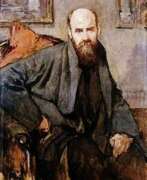

Albert Baertsoen was a Belgian painter, pastellist and graphic artist. His debut as a painter came in 1887, when he participated in an exhibition in Brussels held by the secessionist group l'Essor. He continued his studies in Paris, at the art school of Alfred Philippe Roll, and exhibited at the Salon in 1889. In 1894, he helped found the "Cercle des Beaux-Arts d'Ostende". From 1896 to 1901, he continued to exhibit throughout Europe, winning several Gold Medals. In 1913, he served as a member of the art jury for the Ghent World's Fair. During World War I, he lived in London, returning to Ghent in 1919. That same year, he was appointed a member of the Royal Academy of Belgium.
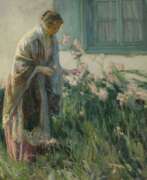

Myron G. Barlow was an American painter and illustrator known for his genre scenes, portraits, and landscapes. He was began his artistic training at the Art Institute of Chicago. Later, he studied at the Académie Julian in Paris, where he was influenced by the Impressionist and Post-Impressionist movements.
Barlow worked as an illustrator for various publications, including Harper's Weekly, Scribner's Magazine, and The Saturday Evening Post. He also taught at the Art Students League in New York City.
Barlow's paintings often depicted everyday life, with a focus on working-class people and their surroundings. His use of color and light gave his paintings a sense of warmth and intimacy.
Barlow was a member of several art organizations, including the National Academy of Design, the Society of American Artists, and the American Watercolor Society. He received numerous awards and honors during his lifetime, including a gold medal at the Panama-Pacific International Exposition in San Francisco in 1915.
Today, his paintings can be found in several museums and institutions, including the National Gallery of Art in Washington, D.C., and the Brooklyn Museum in New York City.
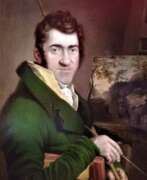

George Barret the Younger was a British painter, master watercolorist and landscape painter.
He was the son of the Irish painter George Barret the Elder (1730-1784) and learned painting from his father. He exhibited at the Royal Academy from 1800 and was one of the first and active members of the Society of Watercolor Painters, which was formed with his own encouragement in 1804. His early works were mainly topographical landscapes in a style similar to his father's watercolors. Later he switched to more romantic compositions with imaginary landscapes.
In 1840, George Barret published The Theory and Practice of Watercolor Painting.
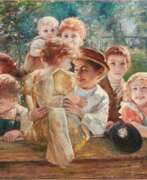

Paul Barthel was a German genre painter and portrait painter. He studied painting from 1877 at the School of Applied Arts in Dresden and then at the Royal Prussian Academy of Arts in Berlin with Julius Ehrentraut and Eugen Bracht.
Paul Barthel worked in Dresden, where he focused mainly on watercolours. In 1922 he settled in Bamberg, where he worked as a restorer.


Jules Bastien-Lepage was a French painter closely associated with the beginning of naturalism, an artistic style that emerged from the later phase of the Realist movement.
His most famous work is his landscape-style portrait of Joan of Arc which currently resides at the Metropolitan Museum in New York City.
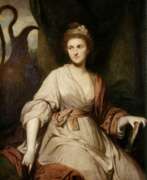

Diana Beauclerk, born Diana Spencer, was an English painter.
Diana Beauclerk was highly gifted, painting portraits, illustrating plays and books, creating designs for Wedgwood's pioneering ceramics and decorating rooms with frescoes.
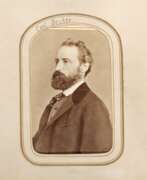

Carl Emil Rudolf Ludwig Becker was a German marine artist.
He was awarded gold medals at the International Art Exhibition of 1894, in Vienna, and the Große Berliner Kunstausstellung of 1896. Three years later, he was one of the co-founders of the Düsseldorfer Künstler-Vereinigung (artists' association). After the turn of the century, marine painting was heavily promoted by Kaiser Wilhelm II, who was attempting to make Germany a major sea power. As a result, the demand for Becker's paintings increased farther inland.
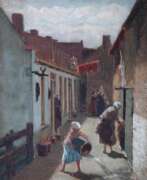

Fridolin Becker was a Dutch painter. Becker studied from 1847 to 1859 at the Koninklijke Academie van Beeldende Kunsten in The Hague, including four years with David Bles. He spent the year 1852 studying in Paris. He was a member of Pulchri Studio. From 1858 to 1860 he worked in Zuilen near Utrecht. He taught at the Hague Art Academy for 33 years.
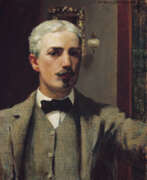

James Carroll Beckwith was an American landscape, portrait and genre painter whose Naturalist style led to his recognition in the late nineteenth and very early twentieth century as a respected figure in American art.
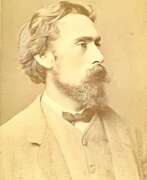

Adalbert Franz Eugene Begas is a German painter and portrait painter. In 1862, Adalbert followed his brother, the sculptor Reinhold, to the Grand Ducal Saxon School of Art in Weimar, where he began working in the workshop of Arnold Böcklin.
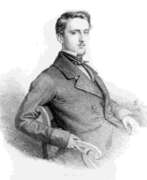

Hiob Carl Oscar Begas was a German painter of the mid-nineteenth century. He is known as a portraitist, landscape painter, historian, teacher, son of the painter Carl Begas, brother of the sculptors and painters Carl, Rheingold and Adalbert Begas.
Oscar Begas was the author of portraits of many prominent German and foreign statesmen and military figures, representatives of science and culture. Becoming a popular painter, he received many orders from King Friedrich Wilhelm IV of Prussia. According to critics, more than in commissioned portraits, Begas's painterly skill was demonstrated in his atmospheric winter and autumn landscapes, on which the master concentrated towards the end of his life.
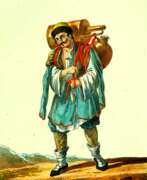

Karl Petrovich Beggrov (Russian: Карл Петрович Беггров) was a Russian artist known for his exceptional lithographs and watercolor paintings. Born in 1799, Beggrov studied at the St. Petersburg Academy of Arts under M.N. Vorobyov and later worked in his brother's lithographic workshop. His talent spanned various art forms, including portraits, landscapes, and cityscapes, which captured the essence of 19th-century St. Petersburg.
Beggrov's work is particularly celebrated for its detailed and vivid portrayals of St. Petersburg. His series "Views of St. Petersburg and Its Environs," created between 1821 and 1826, remains one of the most significant contributions to early Russian lithography. These works were a collaborative effort with other artists, yet Beggrov's distinctive style is evident in the 28 lithographs he produced for the series.
Several of Beggrov's artworks are housed in major museums, including the Metropolitan Museum of Art. Notable pieces like "Our Lady of Vladimir Church in St. Petersburg" and "View of the Arch of the General Staff Building Towards the Winter Palace" showcase his mastery of lithography and his ability to convey architectural grandeur with precision.
For collectors and art enthusiasts, staying updated on Karl Petrovich Beggrov's works is essential. Subscribe to our updates for notifications on new product sales and auction events related to Beggrov's art.
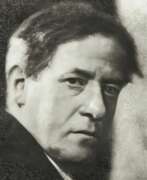

Abraham Adolf Behrman was a Polish artist of Jewish origin, best known for his paintings of Jewish shtetl life in the open air as well as landscapes and group portraits. He spent most of his life in Łódź and was killed during the liquidation of the Białystok ghetto during the Holocaust.
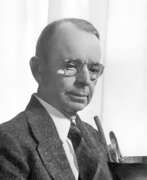

Oscar Edmund Berninghaus was an American artist and a founding member of the Taos Society of Artists. He is best known for his paintings of Native Americans, New Mexico and the American Southwest. His son, Charles Berninghaus (1905–1988), was also a Taos artist.
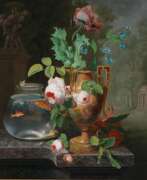

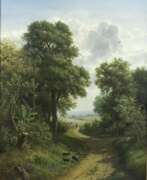

Jan Daniel Beynon was a Dutch-Indonesion landscape, figure and portrait painter. He studied 1848-55 as pupil of C. Kruseman and N. Pieneman at the Amsterdam academy and exhibited in that town repeatedly between 1852 and 1867. In 1855 he returned to the Dutch colony Indonesia; his oeuvre mainly consists of landscapes and persons of that region.
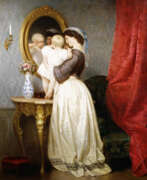

Robert Beyschlag was a German painter of the 19th century. He is known as a painter, famous for his paintings of mythological subjects and portraits of women.
Beyschlag early in his career created genre paintings depicting the medieval era, but later turned his attention to mythology, a prime example of which is the oft-repeated depiction of Psyche in his works. Inspired by Romanticism, the artist also created pastoral subjects with peasant women and shepherdesses. His work was characterized by optimism, theatricalization and idealization of characters, as well as rich colorism. He also created frescoes for the Bavarian National Museum in Munich, depicting scenes from the history of the Crusades.


Edmond Bille was a Swiss artist. Bille engaged in intense and varied activity as painter, engraver, stained glass artist, journalist, writer, and politician. He is the creator of the stained glass windows around the altar of the Cathedral of Lausanne, capital of the Swiss canton of Vaud.
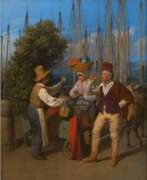

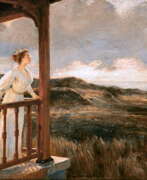

Ernest-Stanislas Blanc-Garin was a Belgian portrait and landscape painter. He came to Brussels in 1863 and became a student of Jean-François Portaels. After that he went to Paris and joined the studio of Alexandre Cabanel, became a student of the Ecole des Beaux-Arts. He took part in the 1867 Prix de Rome competition (“The Murder of Laïus by Oedipus”) and received an honorable mention at this competition in 1868. After a stay in Italy, he settled permanently in Brussels in 1871 and opened a private painting academy. In 1891 he became one of the founding members of the Société des Beaux-Arts de Bruxelles.
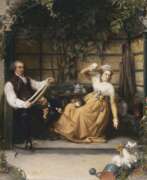

David Bles was a 19th-century painter from the Northern Netherlands. According to the Netherlands Institute for Art History, at the age of thirteen Bles was talented enough to be accepted at the Hague Academy. He attended classes from 1834 to 1837 and from 1838 to 1841. He became a pupil of the painter Cornelis Kruseman and his nephew Jan Adam Kruseman. Bles then travelled to France to study with Joseph-Nicolas Robert-Fleury in Paris. He remained in Paris until 1843 after which he settled in The Hague, though he was a member of the Royal Academy in Amsterdam between 1845 and 1899. He painted scenes from the history of Dutch painting and is best known for portraits and genre paintings.


Ernest Leonard Blumenschein is an American painter, member of the Taos Society of Artists. He is known for his paintings of the American Southwest. He studied at the Cincinnati Academy of Art and the Julian Academy.
Ernest Leonard Blumenschein often depicted Native Americans and landscapes of the Southwest in his paintings. He was known for his masterful use of colour and light, and his works had a strong sense of realism. Blumenschein also worked as an illustrator and writer, and his book Navajo War Dance is considered a classic of Native American literature.
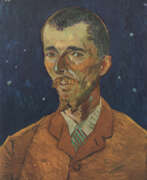

Eugène Boch was a Belgian painter, celebrated for his vibrant contributions to the Post-Impressionist movement. Boch was part of a prominent family known for their fine china business, Villeroy & Boch. He pursued his passion for art in Paris, studying under notable teachers such as Léon Bonnat and Fernand Cormon.
Eugène Boch's artistry is marked by his distinct style and use of color, which earned him spots in prestigious exhibitions like the Salon in Paris during the 1880s. His works, characterized by their emotional depth and innovative techniques, reflect the bold spirit of the Post-Impressionist era. He was not only a painter but also a visionary, whose works resonated with the aesthetic shifts of his time.
One of Eugène Boch's most notable associations was with Vincent van Gogh, who painted Boch in the famous portrait "The Poet," which Van Gogh described as a vision of idealistic and artistic purity. This painting is now housed at the Musée d'Orsay, symbolizing their profound connection and mutual respect. Boch's own works, like "The Red Roofs," demonstrate his unique ability to blend reality with his visionary outlook, showcasing scenes filled with vivid colors and dynamic compositions.
Eugène Boch's legacy extends beyond his paintings. Upon his death in 1941, he left a significant impact on the cultural heritage of Europe, influencing future generations of artists. His works continue to be celebrated in major museums and galleries, reminding us of his pivotal role in the development of modern art.
For collectors and experts in art and antiques, Boch's works offer a timeless exploration of Post-Impressionist vibrancy. Sign up for updates and stay informed about new sales and auction events featuring Eugène Boch’s timeless works, ensuring you never miss an opportunity to own a piece of art history.
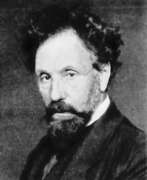

Nikolai Kornilievich Bodarevsky (Russian: Николай Корнилиевич Бодаревский) was a Russian and Ukrainian artist of the last third of the 19th and early 20th centuries of Moldavian origin. He is known as a painter and graphic artist.
Nikolai Bodarevsky created portraits, landscapes and genre paintings. During the early period of his creativity, he was close to the Itinerants, in later years he departed from the Itinerant traditions in the direction of the late "salon" academism. His works are in many museum collections, including the State Tretyakov Gallery in Moscow and the State Russian Museum in St. Petersburg.
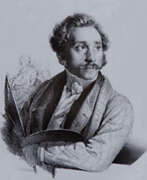

Gottlieb Bodmer was a German painter of the first half of the nineteenth century. He is known as a portrait painter, designer and lithographer.
Bodmer practiced portrait painting for several years, then took up lithography. His most important work of the time was a lithograph of the Sistine Madonna. For some time the artist stayed in Paris, where he improved his technique. He copied engravings, and was especially fond of reproducing paintings by artists of the Munich art school. Bodmer's achievements in lithography laid the foundation for the Bavarian lithographic school, which made Munich famous as the "lithographic capital of Germany".
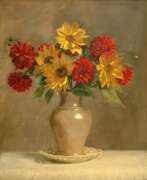

Theodor Bonenberger is a German painter and cavalry officer. He studied with Jacob Grunenwald and Karl von Geberlin at the Stuttgart Art School, then from April 30, 1887 - at the Royal Academy of Arts in Munich with Johann Kaspar Herterich and Carl von Marr. Has been on study trips to Italy, France, Spain and the UK. After completing his studies, he settled in Munich as a freelance artist. Bonenberger also held the rank of major in the cavalry in reserve. From 1895 he took part in many exhibitions in Munich, Düsseldorf and Vienna. In 1936, he completed a portrait of Adolf Hitler, which he presented to Eva Braun for her birthday. He dealt with flower, genre, portrait, landscape and nude painting.
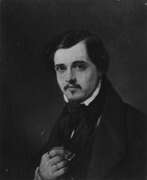

Charles Bonier was a Belgian artist, celebrated for his contributions to painting, lithography, and aquarelle. Born in Brussels in 1814, Baugniet's artistic journey began at the Académie Royale des Beaux-Arts, where he honed his skills under notable instructors. His early forays into lithography, starting in 1827, set the stage for a distinguished career that would intertwine with the cultural and historical fabric of the 19th century.
Charles Boniers artistry gained prominence with his lithographic portraits, particularly those featured in L'Artiste magazine in 1833. His collaboration on a series of portraits for the Belgian House of Representatives further solidified his reputation. However, it was his court appointment as a painter to the Belgian Royal Family in 1841 that marked a significant milestone, elevating his status and expanding his influence beyond Belgian borders.
In 1843, Charles Boniers talents took him to London, where he became a sought-after portraitist among the elite, capturing the likenesses of figures like Prince Albert, Charles Dickens, and Hector Berlioz. His move to Paris in 1860 coincided with the rise of photography, yet Bonier adeptly transitioned, focusing on paintings that reflected the Second French Empire's elegance.
Today, collectors and art enthusiasts cherish Charles Boniers works for their historical value and artistic merit. His ability to capture the essence of his era and subjects makes his art a prized possession in galleries and collections worldwide.
For those fascinated by the intersection of art, culture, and history, Charles Boniers oeuvre offers a compelling glimpse into the 19th century's artistic and societal landscapes. To stay informed about new discoveries and auction events related to Charles Boniers works, sign up for updates and delve deeper into the legacy of this remarkable artist.
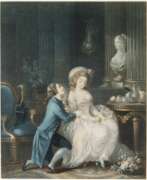

Louis-Marin Bonnet (French: Louis-Marin Bonnet) is a French draftsman and engraver, an outstanding master of metal engraving using the “pencil style” technique. Since 1757, Louis-Marais Bonnet was a student of Jean-Charles Francois, then of Gilles Demarteau. He became famous for his color engravings reproducing drawings by A. Watteau, F. Boucher, Sh.-A. Van Loo, J.-B. Yue. Bonnet reproduced mainly complex pastel drawings, using up to eighty boards per engraving. He used opaque paints that gave a matte tone and tinted paper. He reproduced the spaces by printing with white from a separate board. Bonnet even imitated the golden frames bordering the original drawings. This technique is called “pastel style”. In 1769, Bonnet described his technique in detail in the book Pastel in Engraving, Invented and Executed by Louis Bonnet. In 1765-1767, the French master worked in St. Petersburg, where he completed several engraving portraits in the “pencil style” of Catherine II and the heir Pavel Petrovich based on drawings by Jean-Louis de Velli, then returned to Paris and opened his own workshop.
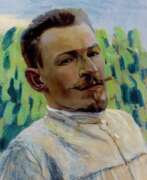

Victor Elpidiforovich Borisov-Musatov (Russian: Ви́ктор Эльпидифо́рович Бори́сов-Муса́тов) was a distinguished Russian artist celebrated for his unique contribution to the Post-Impressionist movement, combining elements of Symbolism, realism, and a decorative style that was all his own. Born in 1870 in Saratov, Russia, into the family of a former serf, Borisov-Musatov overcame early challenges, including a spinal injury that left him humpbacked, to emerge as a pivotal figure in Russian art. His education spanned the Moscow School of Painting, Sculpture and Architecture, and the Imperial Academy of Arts in Saint-Petersburg, further enriched by studies in Paris under the tutelage of Fernand Cormon. His admiration for French contemporaries, especially Pierre Puvis de Chavannes and Berthe Morisot, profoundly influenced his artistic direction.
Borisov-Musatov is renowned for his lyrical, evocative works that often depict the serene and idyllic life of the 19th-century Russian nobility, set against the backdrop of their estates. This half-illusory world, which he masterfully created, reflects a deep nostalgia and a retreat from the industrial harshness of his time. By integrating figures seamlessly into the landscapes, as seen in masterpieces like "The Pool" (1902) and "The Phantoms" (1903), he achieved a harmony that resonates with viewers for its beauty and tranquility. His use of mixed media, including tempera, watercolor, and pastel, allowed for subtle visual effects, making his works distinctive in their soft, dreamlike quality.
Borisov-Musatov's legacy extends beyond his paintings; he was a significant figure in the Russian Symbolist movement and a founding member of the Moscow Association of Artists. His works, which provide a poignant, poetic commentary on the era he lived in, are celebrated in Russian and international art circles alike. Notable paintings like "The Pool" and "The Phantoms" not only highlight his technical skill but also his ability to evoke emotion and atmosphere, making them favorites among collectors and art enthusiasts.
For collectors and experts in art and antiques, Borisov-Musatov's oeuvre offers a fascinating glimpse into the Russian Symbolist movement and the broader cultural milieu of the late 19th and early 20th centuries. His works, preserved in museums and private collections around the world, continue to enchant and inspire.
For those interested in staying informed about new product sales and auction events related to Victor Elpidiforovich Borisov-Musatov, subscribing for updates is highly recommended. This subscription ensures that enthusiasts and collectors alike will not miss the opportunity to own a piece of this remarkable artist's legacy, encapsulating the elegance and serenity that define his work.
